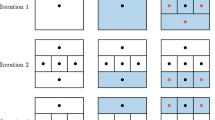Abstract
Cut search is a new approach for solving integer programs based on extending edges of a cone to probe the solution space for sets of hyperplanes that are “proxies” for solution points in the space. Once all proxy hyperplanes associated with a given point have been intersected by at least one of the extended edges, this point is included in a set of points to be examined for feasibility (algorithmically or by inspection). Thereupon, all edges of the cone are extended an additional distance to create a cut by passing a hyperplane through the endpoints of these extended edges.
The flexibility of the cut search procedure permits a variety of strategies for exploring and cutting into the solution space. One useful version arises by taking the proxy hyperplanes to be members of a “positive” or “semipositive” coordinate system. Relative to such a system the procedure can be organized to reduce the set of vectors to be examined for feasibility and also to generate deeper cuts at the end of the edge probe.
Similar content being viewed by others
References
Egon Balas, “The intersection cut — A new cutting plane for integer programming” (Management Sciences Research Report No. 187, Carnegie—Mellon University, October, 1969)Operations Research 19 (1971) 19–39.
Egon Balas, “Alternative strategies for using intersection cuts in integer programming”, presented at the TIMS XVII International Conference, London, July 1970.
Egon Balas, V. Joseph Bowman, Fred Glover and David Sommer, “An intersection cut from the dual of the unit hypercube” (WP #90-69-7, Carnegie—Mellon University, April 1970)Operations Research 19 (1971) 40–44.
Claude A. Burdet, “A class of cuts and related algorithms in integer programming”, Management Sciences Research Report No. 220, Carnegie—Mellon University, September 1970.
Fred Glover, “Convexity cuts”, working paper, School of Business, University of Texas, Austin, December 1969.
Fred Glover, “Convexity cuts and cut search” (MSRS 70-2, School of Business, University of Colorado at Boulder, July 1970)Operations Research, to appear.
Fred Glover and D. Klingman, “The generalized lattice point problem” (MSRS 71-3, School of Business, University of Colorado, Boulder, May 1971), presented at the 39th National OSRA Meeting, Dallas, May 1971.
Ralph Gomory, “An algorithm for the mixed integer problem”, Research Memorandum RM-2597, Rand Corporation, Santa Monica, 1960.
M. Raghavachari, “On the zero–one integer programming problem” (Technical Report No. 20, Department of Statistics, Carnegie—Mellon University, Pittsburgh, Pennsylvania),Operations Research 17 (1969) 680–685.
Hoang Tui, “Concave programming under linear constraints”,Doklady Akademii Nauk SSSR, 1964 (in Russian),Soviet Mathematics (1964) 1437–1440 (English translation).
Richard D. Young, “New cuts for a special class of 0–1 integer programs”, Research Report in Applied Mathematics and Systems Theory, Rice University, Houston, Texas, October 1968.
Richard D. Young, “Hypercylindrically deduced cuts in zero–one integer programs” (Rice University, Houston, Texas, June 1970),Operations Research, to appear.
Author information
Authors and Affiliations
Rights and permissions
About this article
Cite this article
Glover, F. Cut search methods in integer programming. Mathematical Programming 3, 86–100 (1972). https://doi.org/10.1007/BF01584977
Received:
Revised:
Issue Date:
DOI: https://doi.org/10.1007/BF01584977




